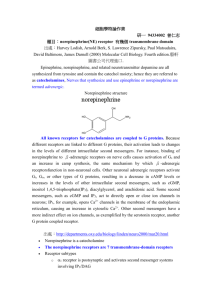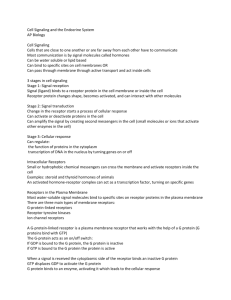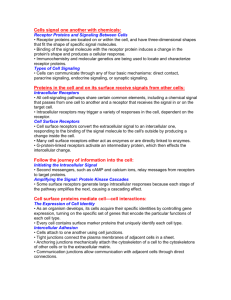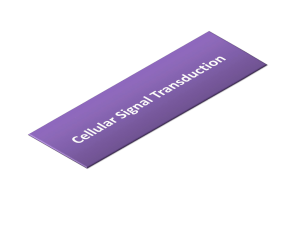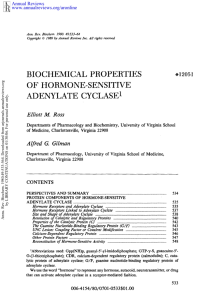Chem*3560 Lecture 34: G-protein coupled receptors
advertisement
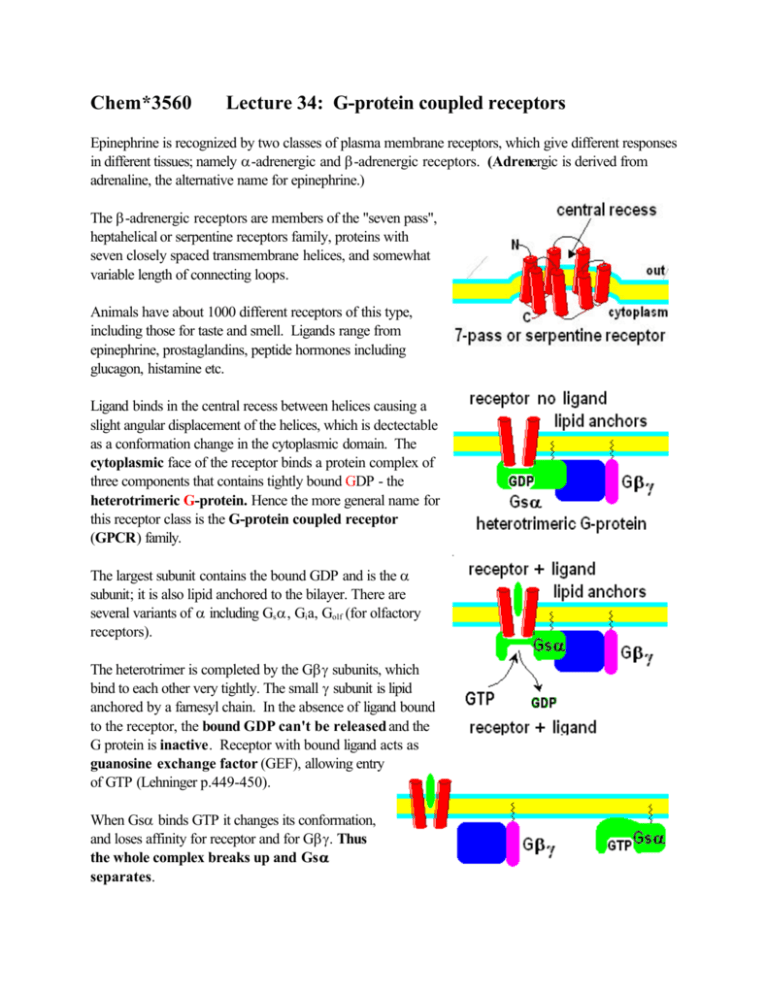
Chem*3560 Lecture 34: G-protein coupled receptors Epinephrine is recognized by two classes of plasma membrane receptors, which give different responses in different tissues; namely α-adrenergic and β-adrenergic receptors. (Adrenergic is derived from adrenaline, the alternative name for epinephrine.) The β-adrenergic receptors are members of the "seven pass", heptahelical or serpentine receptors family, proteins with seven closely spaced transmembrane helices, and somewhat variable length of connecting loops. Animals have about 1000 different receptors of this type, including those for taste and smell. Ligands range from epinephrine, prostaglandins, peptide hormones including glucagon, histamine etc. Ligand binds in the central recess between helices causing a slight angular displacement of the helices, which is dectectable as a conformation change in the cytoplasmic domain. The cytoplasmic face of the receptor binds a protein complex of three components that contains tightly bound GDP - the heterotrimeric G-protein. Hence the more general name for this receptor class is the G-protein coupled receptor (GPCR) family. The largest subunit contains the bound GDP and is the α subunit; it is also lipid anchored to the bilayer. There are several variants of α including Gs α, Gi a, Golf (for olfactory receptors). The heterotrimer is completed by the Gβγ subunits, which bind to each other very tightly. The small γ subunit is lipid anchored by a farnesyl chain. In the absence of ligand bound to the receptor, the bound GDP can't be released and the G protein is inactive. Receptor with bound ligand acts as guanosine exchange factor (GEF), allowing entry of GTP (Lehninger p.449-450). When Gsα binds GTP it changes its conformation, and loses affinity for receptor and for Gβγ. Thus the whole complex breaks up and Gs α separates. The Gs α -GTP complex stimulates adenylate cyclase Gsα-GTP remains membrane associated because of its lipid anchor. The presence of GTP increases its affinity for another membrane associated protein, adenylate cyclase, and when Gsα-GTP binds, adenylate cyclase is stimulated to produce cyclic AMP (Lehninger p.451). Gs α denotes the stimulatory G protein. Other GPCR, for example the α2-adrenergic receptor and opioid drug receptors, may release the closely related Giα α as a GTP complex. Giα is an inhibitor of adenylate cyclase, and opposes the effect of Gsα.. Gsα α and Giα α hydrolyse GTP over a period of time Gsα is a slow GTPase (turnover 3 hr–1 ), so that eventually Gsα reverts to its inactive GDP state, and dissociates from adenylate cyclase, shutting down its activity. Gsα α -GDP then re-assembles as a heterotrimeric complex with its GPCR until fresh ligand arrives to bind to the receptor. However unlike the the Ras-GTP-Raf complex, adenylate cyclase does not appear to have GTPase accelerator protein (GAP) activity, and the decay of Gsα remains slow. The GTPase activity is purely a mechanism to set a time limit on the lifetime of active Gsα. Giα also hydrolyses GTP very slowly, however some of its activation targets such as phospholipase Cβ do act as GAPs. Cyclic AMP phosphodiesterase turns off the cyclic AMP signal Cyclic AMP is broken down by the enzyme 3',5'-cyclic nucleotide phosphodiesterase. This enzyme is inhibited by caffeine, leading to cyclic AMP induced glucose release and high catabolic rate that is sustained longer than usual. Sildenafil (Viagra) is a selective inhibitor of the phosphodiesterase 5 isozyme. This isozyme targets cyclic GMP for hydrolysis, and cyclic GMP relaxes vascular smooth muscle, increasing blood flow. By inhibiting the phosphodiesterase, cyclic GMP levels stay high for longer. Gβγ βγ plays a secondary signalling role When Gsα-GTP releases the Gβγ pair, they can act to modulate certain process, e.g. Gβγ activates certain protein tyrosine kinases, as well as phospholipase Cβ and some ion selective channels. Desensitization of GPCRs The β-adrenergic receptor can be phosphorylated by the protein kinase A cascade, although not by protein kinase A itself. When phosphorylated, the receptors are drawn off in endocytotic vesicles, and temporarily unavailable to respond to epinephrine. Thus the response to epinephrine gradually attenuates. A caffeine "crash" is the result of sustained cyclic AMP levels following ingestion of caffeine. The short term effect is a high induced by glucose release into the blood, but after sustained use or an excess of caffeine, the β-adrenergic receptors are withdrawn from the plasma membrane and not available to respond to a genuine signal that blood glucose level is low. Cholera toxin blocks the GTPase action of Gs α Cholera toxin is an enzyme that transfers ADP from NAD + and adds it to a key Arg side chain in Gsα. This prevents GTP hydrolysis, so that the Gsα is left permanently in the stimulatory state. In vivo, cholera toxin enters the body through intestinal cells, so it exerts its effects there. Normally, cyclic AMP induces secretion of digestive fluids from the epithelium into the intestinal lumen. This process goes totally out of control, so that the volume of fluid expelled becomes far more than the intestinal system can handle. Certain pathogenic strains of E. coli produce enterotoxins with similar but milder effects. If contaminated food is heated, this denatures the toxin, but does not necessarily kill the organism. Pertussis toxin blocks the ability of Giα to replace bound GDP with fresh GTP. The result is that Giα no longer provides a counterbalance for Gsα, again allowing the adenylate cyclase to be excessively stimulated. The difference in the diseases is due to the location in the body where each organism strikes, lungs and bronchial passages for Pertussis (whoopin cough).

